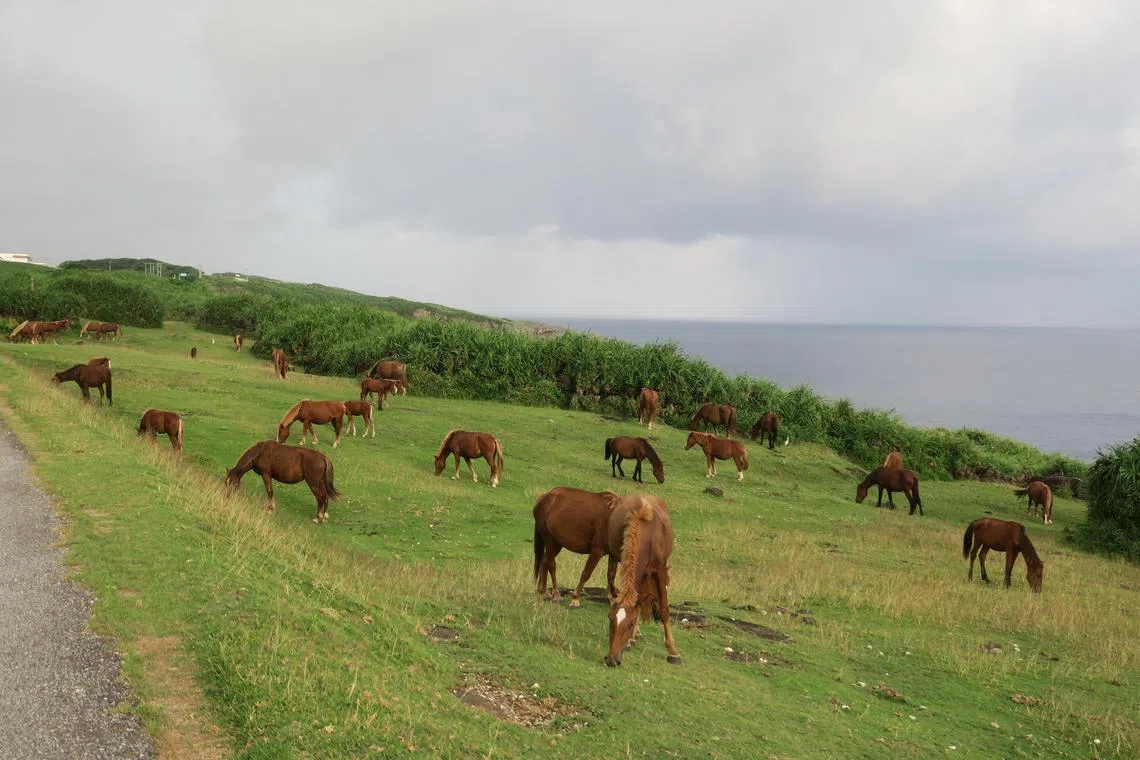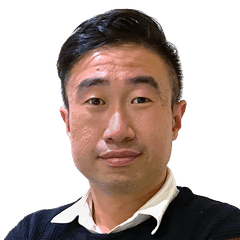Buoys, drones, warships: Japan on high alert as China ramps up activities near Taiwan
Sign up now: Get ST's newsletters delivered to your inbox

An F-15 fighter jet taking off from Naha Air Base in Okinawa, Japan.
PHOTO: NAHA_AIRBASE/X
Follow topic:
YONAGUNI/NAHA (Okinawa) – A Chinese buoy placed south of Yonaguni Island, Japan’s westernmost point located just 111km from Taiwan, is now a simmering cause of diplomatic friction despite earlier signs of warming ties between Asia’s two largest economies with a flurry of political and business exchanges.
Japan discovered the contentious float, installed without any prior notice, within its exclusive economic zone (EEZ) in December 2024, and has since been demanding its removal. Within its EEZ, Japan has exclusive rights for activities such as fishing and drilling.
China has refused to remove the buoy, arguing that it is legal and intended purely for meteorological observations.
Military experts say that such floating devices have the potential to be used for nefarious purposes, much like how the Chinese weather balloons
Data recorded by the buoy – such as the speed and direction of ocean currents, as well as water temperatures – could be exploited by the Chinese navy. The instrument could also be used for surveillance purposes.
While Japan argues that setting up structures within its EEZ without its consent is in violation of the UN Convention on the Law of the Sea, the area in question has overlapping claims by Japan, China and Taiwan.
Thus, China argues that structures – especially for scientific research – are “reasonable and legal”.
Yet, its abrupt appearance – taken together with other recent actions by the People’s Liberation Army (PLA) – has put Japan’s security apparatus on edge across the Nansei Shoto south-western island chain that stretches 1,200km between the tip of Kyushu on Japan’s mainland and Taiwan.
On Feb 26, China flew a reconnaissance and attack drone near the islands for the first time, prompting scrambles by the Air Self-Defence Force (ASDF).
This followed China’s first-ever violation of Japanese airspace in August 2024,
In December 2024, the Chinese navy and coast guard also held for the first time what Japan assesses to be a naval blockade exercise in regional waters, with heavily armed vessels. This took place amid a trend of Chinese and Russian ships frequently plying the international waters of the Miyako Strait that connects the East China Sea and Pacific Ocean.
Japan has ongoing territorial disputes with China, over the uninhabited Senkaku/Diaoyu islets in the East China Sea that are administered by Japan and claimed by China.
Its sovereign disputes with Russia, meanwhile, are over islands north-east of Hokkaido that Moscow administers, calling them the Southern Kurils, but are claimed by Japan, which calls them the Northern Territories.
The Nansei Shoto will inevitably be within the theatre of conflict
To prepare for the worst, Japan has green-lit the military use of civilian airports and sea ports across the island chain.

Japan’s Parliamentary Vice-Minister of Defence Kazuhiro Kobayashi (left) being given a situational update by a Ground Self-Defence Force member on Japan’s westernmost island of Yonaguni on Feb 3.
PHOTO: MODJAPAN_JP/X
After US President Donald Trump and Japanese Prime Minister Shigeru Ishiba held their first summit on Feb 7,
The installation of the Chinese buoy, Yonaguni Mayor Kenichi Itokazu said, was clearly a strategic act.
“Very regrettably, China has been steadily taking actions big and small around our waters,” he told foreign media on Feb 14 in response to a question from The Straits Times. “They are waiting to see how Japan will react to their provocations. I want the Japanese government to respond firmly to this.”
Mr Itokazu, a 71-year-old native of Yonaguni who was first elected in 2021, has long been an advocate for stronger military presence and deterrence, having witnessed the growing Chinese assertiveness in the region since he took office.
He believes that Japan should amend its pacifist Constitution to further toughen its military posture, and would do well to address what he sees as an “asymmetrical relationship” in its security alliance with the US.
He disagreed that fortifying Yonaguni would only make it a target when war breaks out, a notion that is being perpetrated by those who are arguing against a tougher military posture in Japan. He argued that the opposite was true – having minimal defences for such a strategic island would instead make it a target.
“Yonaguni is small, but we must make sure that nothing is allowed to happen to it,” Mr Itokazu said.

The island was put on high alert in August 2022 when China fired five ballistic missiles
Japan is fast militarising the Nansei Shoto in the name of deterrence, with Self-Defence Force (SDF) garrisons having been built in quick succession on islands such as Amami-Oshima, a Unesco World Heritage site, as well as the luxury resort islands of Miyako and Ishigaki.
Yonaguni, meanwhile, is a sleepy island with azure waters and free-roaming critically endangered Yonaguni horses, from which the mountain ranges of Taiwan can be seen on a clear day and, on occasion, the artillery fire of Taiwan’s military training can be heard.

Critically endangered Yonaguni horses roam freely on Yonaguni, Japan’s westernmost island.
ST PHOTO: WALTER SIM
A Ground Self-Defence Force (GSDF) base opened on Yonaguni in 2016, immediately reversing its population decline from a low of 1,483 people in 2015 to the current 1,695 people after the arrival of SDF personnel and their families.
But Mr Itokazu believes Yonaguni, which now routinely hosts joint military exercises between the SDF and US forces as the westernmost frontier, should be doing more.
He welcomes a plan, announced by Defence Minister Gen Nakatani on Jan 22, to build facilities on Yonaguni for the deployment of surface-to-air guided missile units. That same afternoon, a Chinese unmanned aircraft had flown between Taiwan and Yonaguni, prompting the ASDF to scramble fighter jets in response.

Yonaguni Mayor Kenichi Itokazu (third from left) meeting Japan’s Defence Minister Gen Nakatani (across Mr Itokazu) at the Yonaguni Town Hall in Okinawa on Jan 22.
PHOTO: MODJAPAN_JP/X
And then there remains the question of the Chinese buoy, which is still off Yonaguni despite Beijing having separately in February removed another buoy
Japan’s top government spokesman Yoshimasa Hayashi said on Feb 12 that Tokyo would continue to strongly demand the prompt removal of the object off Yonaguni.
The conservative Sankei Shimbun daily went further, urging Tokyo to take proactive action, like the Philippines’ unilateral removal of Chinese floating barriers
“Japan should simply and quickly remove any buoys installed in violation of international law and make China pay the costs,” the newspaper said on Feb 20.
Even as military presence has drastically grown across the south-west island chain, the linchpin of Japan’s defences is based in Okinawa’s prefectural capital of Naha.
Here, the ASDF’s Southwestern Air Defence Force with 3,300 personnel is the busiest of Japan’s four regional air forces.
Its Naha Air Base is located beside the Naha International Airport, where military fighter jets share runways with civilian aircraft and are given priority for take-offs.

F-15 fighter jets at Japan’s Air-Self Defence Force Naha Air Base in Okinawa during a tsunami response training on Sept 8, 2023.
PHOTO: NAHA_AIRBASE/X
Colonel Takeya Serikawa, the chief of staff of the Southwestern Air Defence Force, said that scrambles in response to foreign military aircraft are important to “demonstrate a strong will to protect Japanese sovereignty and territorial integrity”.
“We are forced to respond to activities of PLA aircraft on nearly a daily basis,” he said, while also observing that China and Russia were deepening their military cooperation.
Former Okinawa vice-governor Kurayoshi Takara, who is now professor emeritus at the University of the Ryukyus, called for more diplomacy to ensure that Japan and China are not embroiled in conflict, including over the disputed Senkaku/Diaoyu islets.
“The most important thing is to ensure that Japan and China do not rush into any situations that would invite tension,” he said. “The two countries should build a relationship of trust and, on that basis, have logical and cool-headed discussions to build understanding.”
Walter Sim is Japan correspondent at The Straits Times. Based in Tokyo, he writes about political, economic and socio-cultural issues.


